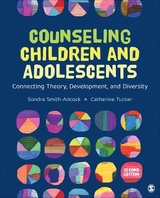
Counseling Children and Adolescents
SAGE Publications Inc (Verlag)
978-1-4833-4774-5 (ISBN)
"The integration of CACREP Standards, school counseling strategies, and specific developmental issues make this a great text for teaching child and adolescent counseling courses."
- Janet Froeschle, Texas Tech University
Counseling Children and Adolescents: Connecting Theory, Development, and Diversity reviews the most relevant theoretical approaches for counseling children and focuses on connecting key theories to application using case studies. The book’s approach is broad, addressing a range of ages, approaches, and interventions that are applicable to varied settings. Sondra Smith-Adcock and Catherine Tucker have laid out an integrated framework that focuses on development and diversity. In addition, a unique aspect of this text is its focus on neuroscience, the developing brain, and the impact of early childhood trauma on development. Each chapter in the text includes a set of case illustrations, guided activities for the student to apply independently and in the classroom, and a list of resources in print, on the web, and on film.
Counseling Children and Adolescents: Connecting Theory, Development, and Diversity is part of the SAGE Counseling and Professional Identity Series, which targets specific competencies identified by CACREP (Council for Accreditation of Counseling and Related Programs).
Sondra Smith-Adcock holds a PhD in counseling and counselor education from the University of North Carolina at Greensboro. She has taught at the University of Florida for 20+ years in both the school counseling and mental health programs. She has authored more than 50 publications on counseling-related topics, with emphasis on counseling children and adolescents. She has counseling experience in schools, agencies, and private practice settings with diverse children of all ages. Catherine Tucker holds a PhD in counselor education from the University of Florida and is a Licensed Clinical Mental Health Counselor Supervisor in North Carolina. She currently operates a private practice in Asheville, NC focused on supporting children and parents who have experienced attachment ruptures and trauma. Dr. Tucker earned tenure in the counseling area programs at Indiana State University, where she taught for 9 years. She has over 20 years of direct counseling experience, including 10 years as a school counselor, and has authored multiple journal articles and book chapters on counseling related issues. She was president of the Association for Child and Adolescent Counseling from 2017 to 2019.
Section I
Chapter 1: Historical and Contextual Trends in Counseling Children & Adolescents: Guiding Frameworks - Catherine Tucker, Ceymone Dyce
Counseling Youth: A Developmental and Multicultural Perspective
Socio-Historical Context of Childhood and Children’s Mental Health Care in the United States
Current Perspectives on Children’s Mental Health Care
Future Trends
Chapter 2: Legal and Ethical Issues in Counseling Children and Adolescents - Sondra Smith-Adcock, Sandra Logan
Children’s Rights
The Child and Adolescent Counselor and the Law: Working Within the Legal System
Ethics of Counseling Children and Adolescents: Best Practices
Professional Organizations
Chapter 3: Attachment, Trauma, and Repair from Infant to Adolescent Development: Counseling Implications from Neurobiology - Mary Vicario, Carol Hudgens-Mitchell, Catherine Tucker, Sondra Smith-Adcock
Brain Development
The Cortexes–Executive Control Center
The Limbic System—Welcoming Center or Guardhouse
Brain Stem—Basic Survival
Neurons—The Building Blocks of the Brain and Nervous System
Mirror Neurons
Neurotransmitters—Brain Chemistry
Adverse Events and Child Development
Developmental Trauma and Diagnosis
Play Counseling for Complex Trauma
Examples of Relationally and Sensory-Based Interventions
Chapter 4: The Counseling Process: Establishing a Therapeutic Alliance - Sondra Smith-Adcock, Jennifer Pereira
The Culture of Childhood and Adolescence
A Survey of Attitudes Toward Children
Relating to the World of Children
Relating to the World of Adolescents
Relating to Children and Adolescents: “What Works”
Focus on the Child, Not the Problem
Relating the Child’s View to Others
Using Therapeutic Responses
Section II
Chapter 5: Psychodynamic Theories - Catherine Tucker, Elaine Wittmann
Sociohistorical Context
Theorists
Chapter 6: Humanistic Approaches - Catherine Tucker, Sondra Smith-Adcock
Sociohistorical context
Theorists
Application to Counseling Settings
Existential-Humanistic Counseling Techniques
Outcome Research
Chapter 7: Cognitive-Behavioral Approaches - Tina Smith-Bonahue, Kaitlyn Tiplady
Socio-historical context
Theorists
Merging Cognitive and Behavioral into CBT
Adapting CBT for Younger Children
Integrative and Cognitive Behavioral Play Therapy
Trauma-Focused CBT
Dialectical Behavior Therapy with Adolescents
Creative Techniques for Using CBT With Children and Adolescents
Outcome Research
Chapter 8: Family and Organizational Systems Approaches - Ellen Amatea, Dayna Watson
Defining Family Systems Counseling
Theorists
Applications in Counseling Settings
Chapter 9: Constsructivist Approaches - Donna Gibson, Shajuana Isom-Payne
Theorists and Tenets of Theories
Techniques and Application of Constructivist Counseling Approaches
Outcome research
SECTION III
Chapter 10: Counseling With Very Young Children (0–4) and Their Families - Catherine Tucker
The Brain and Cognitive Development
Psychosocial Development
Issues and Concerns
Suggestions for Developmentally Appropriate Intervention With Children Ages 0 to 4
Chapter 11: Counseling With Young Children (5–8) and Their Families - Catherine Tucker
The Brain and Cognitive Development
Psychosocial Development
Issues and Concerns
SSuggestions for Developmentally Appropriate Intervention With Children Ages 5 to 8
Chapter 12: Counseling With Older Children (9–11) - Jacqueline Swank, Clarence Anthony
The Brain and Cognitive Development
Issues and Concerns
Suggestions for Developmentally Appropriate Interventions With Children Ages 9 to 11
Chapter 13: Counseling With Young Adolescents (12–14) - Andrea Dixon, Robert Rice, Amanda Rumsey
Developmental Considerations
Issues and Concerns Facing Young Adolescents
Suggestions for Developmentally Appropriate Interventions With Children Ages 12 to 14
Chapter 14: Counseling With Older Adolescents (15–19) - Derrick Paladino, Leigh DeLorenzi
A Time of Rapid Growth and Change
Models of Adolescent Identity Development
Toward a Global Understanding of Adolescent Identity Development
Issues and Concerns: Late Adolescence in the Postmillennial Generation
Suggestions for Developmentally Appropriate Counseling Interventions With Adolescents Ages 15 to 19
Chapter 15: Counseling Emerging Adults (18–21): A Time of Uncertainty and Hope - Laura Choate
Emerging Adulthood
Physical and Cognitive Development
Identity Development
Chickering’s Vectors of Identity Development
Issues and Concerns in Emerging Adulthood
Suggestions for Developmentally Appropriate Counseling Interventions for Emerging Adults
| Erscheinungsdatum | 27.04.2016 |
|---|---|
| Reihe/Serie | Counseling and Professional Identity |
| Verlagsort | Thousand Oaks |
| Sprache | englisch |
| Maße | 187 x 231 mm |
| Gewicht | 590 g |
| Themenwelt | Sachbuch/Ratgeber ► Gesundheit / Leben / Psychologie ► Familie / Erziehung |
| Geisteswissenschaften ► Psychologie ► Entwicklungspsychologie | |
| Medizin / Pharmazie ► Medizinische Fachgebiete ► Psychiatrie / Psychotherapie | |
| Sozialwissenschaften ► Pädagogik ► Sozialpädagogik | |
| Sozialwissenschaften ► Soziologie | |
| ISBN-10 | 1-4833-4774-5 / 1483347745 |
| ISBN-13 | 978-1-4833-4774-5 / 9781483347745 |
| Zustand | Neuware |
| Haben Sie eine Frage zum Produkt? |
aus dem Bereich



